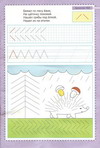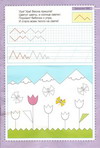Nowadays, we don’t often have to write by hand - more and more we use a keyboard, and recently technologies such as voice input have appeared. And it’s not surprising that writing is becoming a problem - every year there are more and more children who have difficulty learning to write capital letters, and more and more adults who have lost the skill of beautiful handwriting. How to fix this? This manual “Learning to write letters by dots” will come to the aid of both adults and children.
Many people believe that handwriting depends on natural talent. And if your handwriting is clumsy and unclear, there is no way to fix it. But it has long been proven that if you really want something and try your best, then everything will definitely work out. We will give you some tips on how to develop your handwriting so that it becomes clear and beautiful.
Most effective way– develop your handwriting one letter at a time. This is very painstaking, but not meaningless work. Write one letter many times until you like the result. This may take more than one sheet of paper, but your efforts will definitely bring results.
Using copybooks it is easiest to learn to write letters using dots. Working with them, you will have correct and even handwriting. It is worth going through the registration in full and, possibly, more than once. It’s not difficult to study according to the recipes - everything is clear and clearly shown there, you just need to diligently repeat it.
To write beautifully, you need to sit up straight and not slouch. This is very important, because if you sit in the wrong position, it’s unlikely that anything will come of it. Also, many people think that when you write, only your wrist is involved. But that's not true. Our shoulders also help us write.
Try writing in the air by drawing lines. Experts say that after you transfer this to a piece of paper, your handwriting will become more accurate and smoother. Soon he will be absolutely perfect.
Search the web for fonts that you like. And you can carefully copy them.
These recipes are suitable for classes with preschoolers 5-6 years old, but should not be given to children younger age. In 3-4 year olds, the hand is not yet sufficiently formed to print such small elements as letters and numbers. Do not rush, otherwise you may overstrain small muscles, which will lead to further problems with the development of handwriting in the child. For children, we recommend using special ones.
You should also distinguish between copybooks for left-handers and right-handers. This material is suitable for right-handed children. If you or your child writes with the left hand, download special ones.
Remember: you can achieve beautiful handwriting only through your own work and diligence, and the copybooks “Learning to write letters by dots” will help you with this. Good luck!
Writing is one of the most important skills, along with reading, that any person should master. Many parents unreasonably believe that they need to start teaching their child as early as possible, that this skill is the highest indicator of the level of development. Is this true? Many experts agree that you should not start teaching your child to write until he is 5-6 years old. Education beautiful letter Teaching a preschooler is not an easy task; it requires composure, perseverance and attentiveness.
All parents want to be proud of their child and try to teach him to write at an early age. But this approach can only do harm if you don’t know how to deal with your child correctly.Children aged 3-4 years, for the most part, are fidgety. They want to run, jump, play, but not write out some letters and numbers in boring copybooks. If you still decide to teach your child to write, then remember: now you will need to practice penmanship with your child regularly, otherwise after a while he may forget everything you taught him!
Not everyone may like these activities, so he may begin to write letters and numbers quickly and sloppily, wanting to finish with them as quickly as possible and eventually move on to some more interesting things. All this can lead to the development of ugly handwriting, which will not be so easy to correct later. Let's figure out what the experts are talking about: is it worth starting to teach children to write in preschool age, how effective will such classes and their consequences be?
Should parents teach a child under 5 to write?
Teaching children to write at 3-4 years old is not worth it for a number of reasons:
- Children lose the sense of novelty inherent in learning at school. When a student realizes that all they start learning in class is writing numbers and letters, he loses all interest in learning. The child becomes bored and lazy to complete the task. We are no longer talking about any incentive and joy to learn new things every day.
- Writing skills turn out to be incorrect. Two subject matter experts child development(scientist-physiologist Maryana Bezrukikh and specialist in early development Lena Danilova) are convinced that the development of writing skills, including penmanship and speed writing, does not occur in one year, but gradually. This takes years. You shouldn’t throw all your energy into teaching your child to write beautifully. All this may negatively affect his entire style of writing in the future.
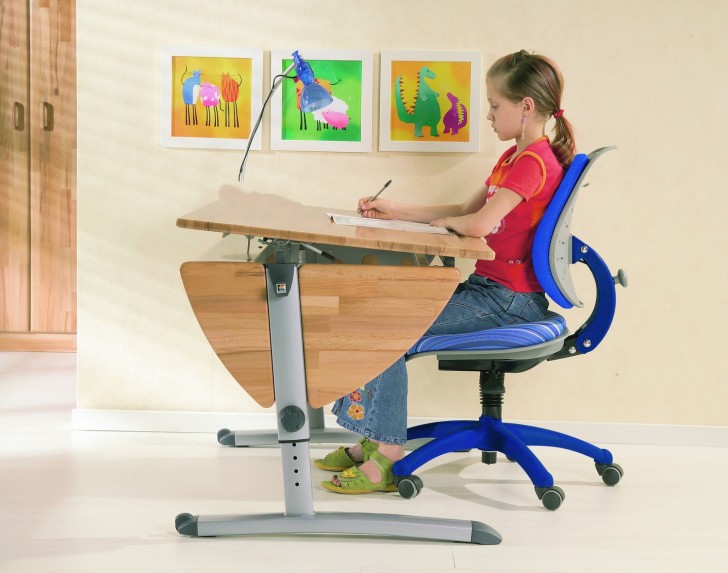 Correct posture must be developed from the very beginning. early age, as soon as the baby takes his first pencil and sits down to draw at the table. This will help avoid many spinal problems in the future.
Correct posture must be developed from the very beginning. early age, as soon as the baby takes his first pencil and sits down to draw at the table. This will help avoid many spinal problems in the future. At first, a preparatory base will be sufficient for training. Teach your baby to sit at the table in the correct position, and also teach how to grasp a pencil or pen. Over time, you can begin the learning process, but remember that it is important to be consistent in your teaching techniques. Each number and each letter should be explained separately, explaining and comparing. A child is only able to fully evaluate the technique of writing a particular letter when he or she is closer to 5-6 years of age.
Haste in learning always only causes harm; it is especially important not to rush at first. By pushing your child, you will cause him to make mistakes in writing individual elements.
Increasingly, irregularities in height and width and slope will occur. It will become almost impossible for your baby to connect letters into words. Then, upon entering first grade, the child will fall into the hands of a teacher who will be forced to correct many of your mistakes.
When should you start?
Usually, it is at school that we learn to write letters and numbers beautifully. Learning to write there takes place in several stages: first, children are shown how to sit at a school desk correctly, then how to hold a pen or pencil. Teachers give the child the first ideas about letters and numbers, talk about what height and width the lines and slopes in them should be, and show how to correctly connect them together.
Early mastery of accurate writing of numbers and letters does not guarantee the preservation of this skill in the future. It is important to place the hand so that the child gets minimally tired during the work. This is a skill, as well as a skill to beautiful handwriting, consists of regular exercises. A baby who loves to run and jump can hardly be forced to sit at a notebook. When parents succeed in this, their only goal is to finish everything quickly so that everyone falls behind, and then run off to play. Such an incorrect approach risks ruining children's handwriting for a long time.
 The child himself must want to learn to write, and until that time classes can be conducted in game form
The child himself must want to learn to write, and until that time classes can be conducted in game form Let us conclude: it is advisable to engage with your child in a playful way. Any learning activity should be presented easily and naturally. Don’t rush to put a 3-4 year old child on a line with copybooks and notebooks. Wait a couple of years, then your successes with him will be more tangible and less painful. Until this time, you should only prepare your little hands for future writing.
Preparing a preschooler to master writing skills
All of the above does not mean that a 5-6 year old child does not need to be prepared for school, because before he begins to learn to write, it is necessary to master a wide variety of skills. This is where the help of parents will come in handy. To do this, it is necessary to pay attention to the development of fine motor skills and coordination of movements. Thanks to full development, the child will be able to write beautifully in the future, so that both his and your eyes will be happy. Teach your baby to do everything carefully, to show diligence and attentiveness. These are the skills that should be developed in children during the preschool period. We are talking about ages from 2 to 5 years. The following activities will help you do this.
Exercises to develop fine motor function
 You can develop fine motor skills in different ways, for example, modeling from plasticine
You can develop fine motor skills in different ways, for example, modeling from plasticine - finger gymnastics: great option stretch naughty fingers - play together a game called “Twister”, only with your fingers;
- make a shadow theater using your hands;
- make applications from all kinds of materials ( colored paper, felt, autumn leaves, grains, etc.);
- learning to cut out (first simple shapes, then more complex pictures);
- make drawings on semolina and sand;
- folding, paper modeling, origami;
- design;
- weaving bracelets and figures from rubber bands;
- activities with loose and small objects (cereals, legumes, pebbles): repeating a pattern, making a mosaic, stringing pasta on a string, etc.;
- modeling from clay, dough, plasticine;
- copybooks, coloring, drawing.
Remind them of the importance of posture. Pay great attention to your position at the table. In the future, while concentrating on the writing process, posture control will be carried out at a subconscious level.
It is very important to teach your baby to hold a pencil from an early age. Today, there are comfortable triangular pencils with a thick diameter on sale. Thanks to them, it will be easier for the child to master this skill. There are also special pencil attachments on sale that teach correct grip.
Don't do the same activity for too long. Alternate activities, and also do not forget about minutes of rest, when it is important to give your fingers and arms the opportunity to rest and relieve tension.
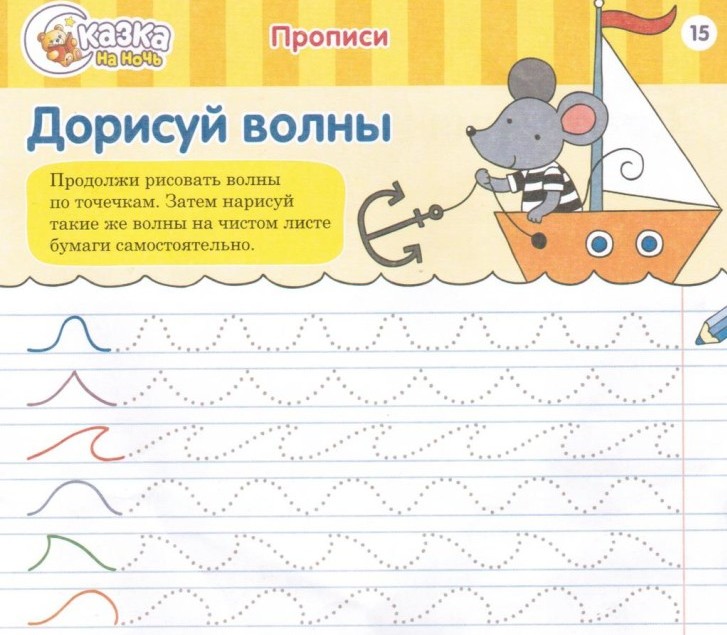 There are many colorful and interesting copybooks for younger children, where the child will learn to trace, shade and much more.
There are many colorful and interesting copybooks for younger children, where the child will learn to trace, shade and much more. The method of teaching writing developed by M.T. has proven itself well. Strizhakova. It's called "From Drawing to Letter." All children love to color and shade drawings. The shading method can also be used in copybooks with wide or narrow rulers.
How to learn to write? This question plagues many parents. If this was previously done in elementary school, then today a child goes to first grade with basic skills. To develop them, you can use materials for preschoolers; store shelves are literally littered with them. But where to start and how to make sure that classes do not turn into torture for your child? Let's figure it out together.
Learning to write - developing fine motor skills.
Ideally, prepare your child for writing a couple of years before school. The most optimal thing is to start at four years old. After all, at this age he can already approach the issue intelligently, but he still has enough time to hone his skills. The baby must master fine motor skills. There are effective ways to develop it:
1) buy a construction set with no large parts. Let him fantasize and collect whatever he wants;
2) for girls, a hobby in which beads or seed beads are strung on a thread can be useful;
3) many people like to sculpt from plasticine or clay; you must agree, this is a very useful and entertaining pastime;
4) and finally, the notorious coloring books are also useful in the development of motor skills, just try to buy one whose characters are interesting to your baby.
By the way, this develops not only motor skills, but also contributes to the formation of attentiveness, perseverance, accuracy and improvement of the eye. And this, without a doubt, will be useful to your baby.
Only when he takes up the pen, do not forget that in order to write beautifully and quickly, he must hold the pencil or pen correctly. Correct mistakes at the root, rather than relearn them for a long time and persistently. By the way, special attachments have appeared on sale that help him hold a pen or pencil.
Learning to write - first copybooks.
When you see that the hand is already ready and does not go beyond the boundaries when coloring, you can begin to copy-paste. This is a very important step for a baby. Of course, at first he won’t succeed. Don't rush or put pressure on him. Even the most horribly written squiggle should receive your praise. Also, ignore the dirt, have fun, this is the only way you can interest your baby.
The first jobs are easy. Before writing, master drawing lines and squiggles. We recommend starting with straight lines, then moving on to inclined ones, and then to curved ones. Pictures will help, with dotted lines for connections. Multi-colored notebooks with small poems or stories are perfect for studying. The more exciting the process, the more effective it will be.
(Click to print)

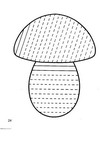
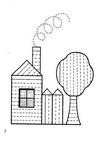
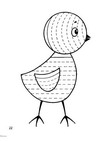
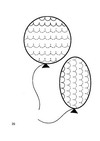
When drawing various stripes is well mastered, you can move on to geometric shapes. Of course, it will be more interesting for the child not only to trace squares or triangles, but to build a real drawing out of them.
(Click to print)

Learning to write - copybooks for the second stage.
When he is already confidently tracing the dotted lines different shapes and length, you can try to proceed to the second stage. Materials where you need to continue the drawing, shade it, or try to repeat a geometric figure will help. At this stage, notebooks may no longer be so bright; as a rule, they begin to study at the age of five or six years, when he already understands that this is important for his later life. Evaluate efforts more strictly, pay attention to dirt and sloppiness. And yet, do not forget to praise your little worker, especially if you see that he is trying and thinking.


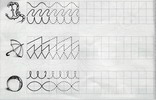
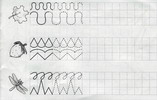
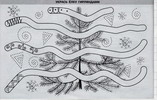
Learning to write letters and numbers.
When he independently learned to draw straight lines and geometric shapes, you should gradually begin to enter letters and numbers. To begin with, these can only be their elements. For example, some drawings that include the same curves. For more diligent and purposeful children, it is suitable where the elements of letters and numbers are written in a row. You need to know the alphabet and numbers, it will be much easier.
(Click to enlarge for printing)
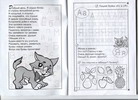
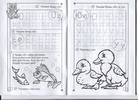
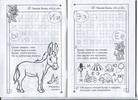
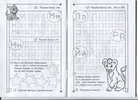
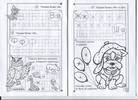
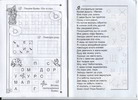
By the way, if your student has already learned to write in print, and there is still enough time before school, you can try teaching him as with first-graders. If he writes, it will be much easier for him later. This requires your baby's attention to the copybooks. After all, capital letters are written according to certain rules so that they can be combined into words. Find a copybook where everything is drawn with arrows showing directions.
Learning to write - attitude.
Attitude is also an important factor. Psychologists have long found out that the beauty and accuracy of handwriting largely depends on the emotional state. You can’t start if the baby is upset. In addition, never compare your baby with other children, especially if the comparison is not in his favor. Never scold a student if he fails to write, but praise him as much as possible for success. Before writing accurately, a long and difficult path will be covered, be a support. Motivation is also important in the mood. You really need to want to write; not only praise, but also a reward (for example, a coveted book) would be quite appropriate.
Among other things, keep in mind that learning also torments the child himself. And this is a huge pressure, especially if you rush it or constantly underestimate it. He may have a protest when he stops trying, and it will be very, very difficult to reverse this situation. Therefore, the more patient you are, the happier your baby will be.
Learning to write - helping the child relax after class.
For you, writing symbols or even words costs nothing, but for your child it is hard mental and physical work, after which he needs to rest and recover. First of all, the time for preschoolers should not exceed twenty minutes. After working on your homework, we advise you to somehow distract yourself. For example, outdoor games or reading a book. It would be a good idea to relax your arm muscles. To do this, you can do the well-known exercise “we wrote, we wrote, our fingers are tired,” or have a short massage session. Focus your attention on your hands and forearms. In order to relax them, you can lightly pinch the muscles, stroke or gently pat them. Such a massage will not only be useful, but also pleasant for the baby.
Learning to write - how to deal with inattention.
Many parents complain that their children are extremely inattentive while peeing. Indeed, kids, whose life until recently consisted of nothing but games and entertainment, are quite reluctant to sit down and write copybooks. As mentioned earlier, you need to prepare physically and mentally. It would be nice if studying brings pleasure not only to him, but also to you. Believe me, he will immediately notice if you are bored. Therefore, you cannot simultaneously watch TV, listen to music or anything else. Immerse yourself as much as possible and help when necessary.
Of course, perseverance also depends on the psychological type of a particular child. Some people cannot sit still for long periods of time. Provide the most comfortable and calm environment possible. Make sure nothing can distract him. If you notice that during the process he begins to change his position frequently, it means he needs a warm-up. It's okay if work is interrupted for a minute for a little charging.
Plus, mindfulness can be developed like any other skill. A warm-up called “each letter has its own color” is suitable for this. Agree with your child that each letter will have its own color (in the game, use only a few, not the entire alphabet), then dictate them to him quickly, but so that he has time to change the pencil and write the letter.
Learning to write - a few fundamental rules.
Whatever copybook you choose, in order to teach effectively, you need to adhere to a couple of rules.
1) Move from simple to more complex. Even if your baby shows extraordinary mental abilities, it’s worth starting with the basics.
2) The more colorful and interesting the copybooks are at first, the more wonderful it will be. It's good for a child to get carried away.
3) Remember about praise and encouragement. But remember that they must be deserved. You need to clearly understand that “you can’t even pull a fish out of the pond without effort.”
4) He will draw more than one copybook with squiggles. Don't worry if he doesn't get it right away, learning is a fairly long process.
5) Never put pressure and especially do not raise your voice on him. If you see that a child does not work, you should firmly but calmly find out the reason why he has no desire. If the baby is simply tired, stop the activity.
6) Do not be guided by the principle that the more you write, the better. The lessons will be of higher quality and more exciting, and then he will be less tired.
7) Recently, it has been widely believed that it is best to learn to write with an ordinary soft pencil. Research shows that indeed, at the beginning of classes with the help a simple pencil the correct pressure is generated.
8) Don’t forget that all children are different, and each one needs an approach. And it’s easiest for parents to find it. And absolutely anyone can be taught to write accurately. True, if your baby is left-handed, quiet, or, conversely, fidgety, you will have to spend a lot of effort on this.
In conclusion, I would like to say that the ability to write beautifully, accurately and competently is a merit not only of teachers and the children themselves, but also of parents who do not waste their lives and work with their children. Therefore, if your child is already four years old, hurry up to buy a lot of different materials, and also be patient and understanding; you are guaranteed hard work for a couple of years. But the pride in a child who will receive excellent grades will more than pay off all the efforts.


